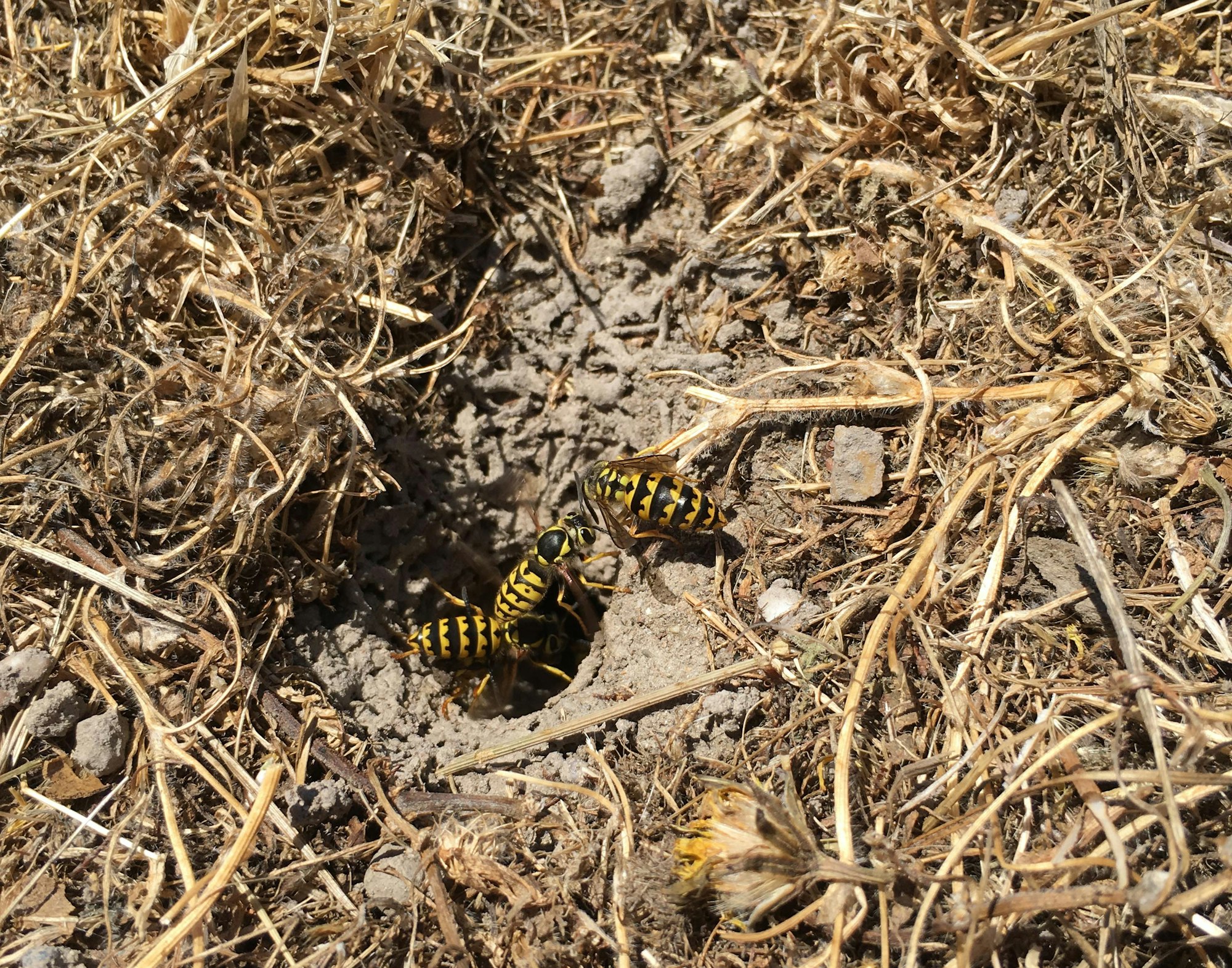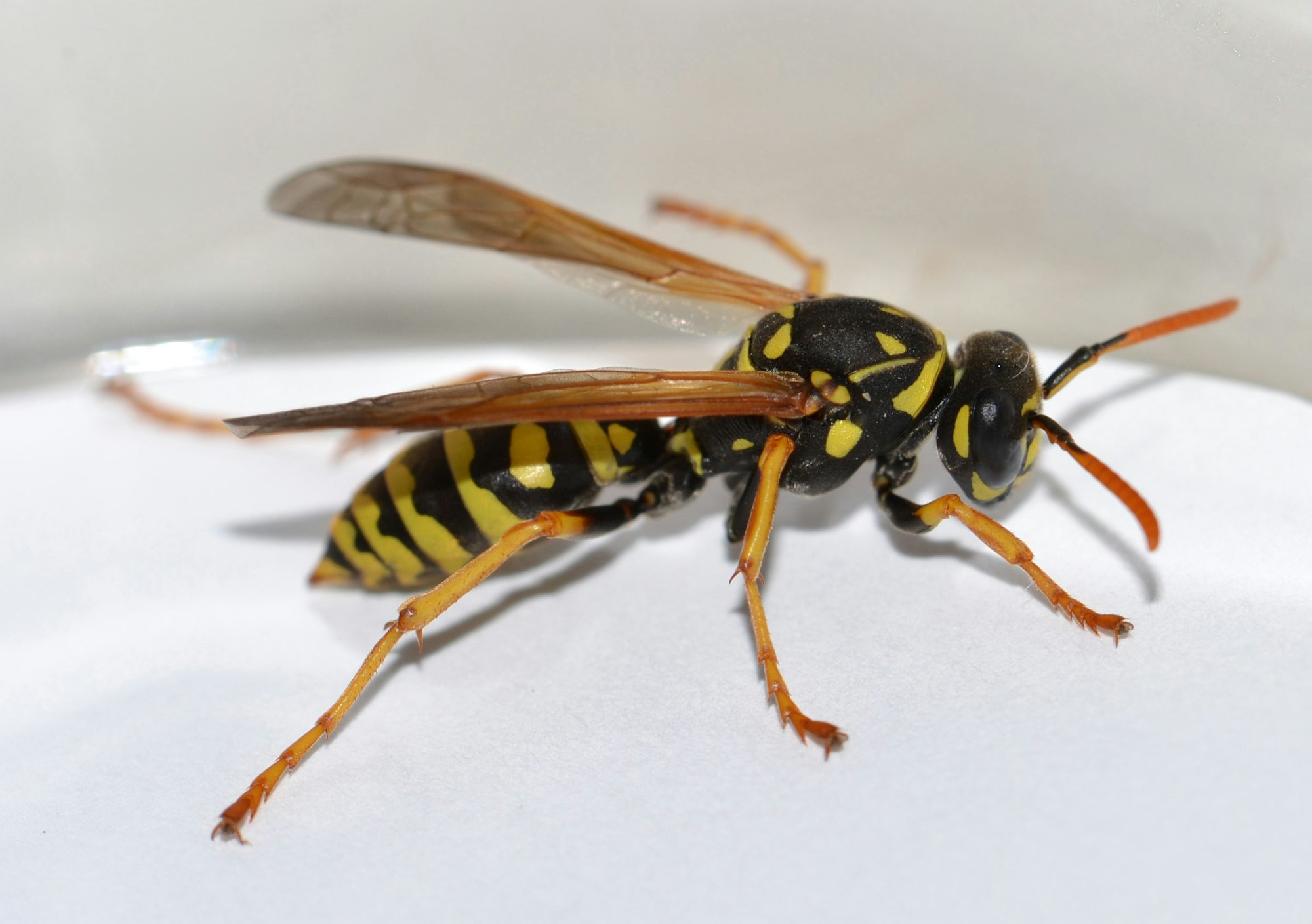The Sting Operation: Yellowjacket Edition

One of the many services our District provides is the control of in-ground yellowjacket nests. This year we have responded to over 4,131 calls for nest eradication- a nearly 165% increase from last year at the same time! Although we are receiving a record number of calls for service, many residents are still having issues with yellowjackets on their property because they can't seem to find the nest.
Yellowjackets often make their nests underground in abandoned gopher holes, but are also known to nest in wood piles, dense vegetation, utility vaults, and other enclosed spaces. They look for food close to their nests, usually staying within 1,000 feet of them. They are most active between 10 a.m. and 4 p.m., though activity slows in extreme heat or cold. To find a nest, begin by searching your property looking for yellowjackets flying in and out of holes (often along a constant "bee line") or a cluster of yellowjackets "guarding" an opening. Even if you find one nest, keep searching in widening circles, as multiple nests may be present. Step carefully as vibrations can trigger aggression from underground colonies. Click here for a more detailed description on how to find a nest.

Once you find the underground nest, mark it so that it can be easily refound by one of our technicians, and call our office at 707-285-2200 or submit a service request online. Remember, we only treat underground yellowjacket nests and we do it for free! If you find a structural nest (one that is attached to a structure or in the wall of a structure) contact your local pest control operator.
Yellowjackets can become extremely aggressive when you approach their nest, so be extra cautious when placing the marker. You do not have to place the marker next to the nest—it can be placed in the general vicinity as long as we have clear instructions on the location. The most important thing is to not place anything in or on top of the nest.
What do we use to treat a nest?

We use a couple of different materials to treat yellowjacket nests. One material is Drione, a low-toxicity dust made from natural, plant-based ingredients—specifically, a compound derived from chrysanthemum flowers—combined with a silica-based drying agent. Our Vector Control Technician carefully applies the material using a specialized bulb duster, directing it into the entrance of the nest.
As yellowjackets enter and exit, they come into contact with the dust and carry it deeper into the nest, helping to spread the material throughout the nest. This material works by disrupting the yellowjackets' nervous system and dehydrating them, providing effective control while breaking down quickly in the environment. After treatment, we always advise keeping yourself, children, and pets away from the area for a few hours due to the aggressive nature of the yellowjackets.
Who’s Nesting in the Ground? Yellowjackets vs. Paper Wasps
Have you ever seen a wasp flying low to the ground or buzzing around your yard and wondered what kind it is, or if it’s something you should be worried about? You’re not alone! Many people confuse yellowjackets and paper wasps, especially when it comes to identifying their nests. Here's how to tell them apart and what to do if you find one.

European paper wasps are a newer arrival in California and are becoming more common. They typically build small, open-air nests under eaves, in shrubs, or tucked into other sheltered spots. However, unlike native paper wasps, they will also nest in cavities—such as pipes, gates, or vents. These wasps will defend their nests, but they are usually less aggressive than yellowjackets unless threatened. European paper wasps may actually help control garden pests because they feed on other insects. But if their nest is in a high-traffic area or if you’re allergic to stings, you may want it removed. The District does not remove paper wasp nests. If needed, homeowners can contact a licensed pest control company for assistance.

Western yellowjackets are a common sight during summer and fall—and they can be aggressive. These wasps often build large, hidden nests underground, especially in abandoned rodent burrows. Western yellowjackets are active hunters. They eat slugs, grasshoppers, flies, spiders, and other insects, but they’re also scavengers and will go after meat or sweet foods—especially at picnics or barbecues. If their underground nest is disturbed, they will defend it—sometimes in large numbers.
Remember, if you find a ground-nesting yellowjacket nest, do not try to remove it yourself. The Marin/Sonoma Mosquito & Vector Control District will safely eliminate the nest at no cost to residents. Give us a call—we’re here to help!
One way you can tell the difference between these two wasps is by the way they look when they fly. The Europeon paper wasp has long dangling legs, while the yellowjacket flies with its legs tucked in.

Another way to tell the difference between a paper wasp and a yellowjacket is by placing a piece of meat outside. The yellowjacket will take a piece of meat back to the nest, while the paper wasp will fly right by it.
Visit our website to learn more about yellowjackets and ways to protect yourself from being stung.
The Marin/Sonoma Mosquito and Vector Control District's programs and services are funded through property taxes and benefit assessments, and are provided to all residents in Marin and Sonoma counties at no additional cost.
